
Abutilon is a large genus of flowering plants in the mallow family, Malvaceae. It is distributed throughout the tropics and subtropics of the Americas, Africa, Asia, and Australia. General common names include Indian mallow and velvetleaf; ornamental varieties may be known as room maple, parlor maple, or flowering maple. The genus name is an 18th-century New Latin word that came from the Arabic ’abū-ṭīlūn, the name given by Avicenna to this or a similar genus.

Hibiscus syriacus is a species of flowering plant in the mallow family, Malvaceae. It is native to south-central and southeast China, but widely introduced elsewhere, including much of Asia. It was given the epithet syriacus because it had been collected from gardens in Syria. Common names include the mugunghwa, rose of Sharon, Syrian ketmia, shrub althea, rose mallow. It is the national flower of South Korea and is mentioned in the South Korean national anthem.

Abutilon pictum, syn. Abutilon striatum,(disputed), is a species of flowering plant in the family Malvaceae. It is native to southern Brazil, Argentina, Paraguay and Uruguay. The plant has become naturalised in Central America, and is used in horticulture. Common names include redvein abutilon, red vein Indian mallow, redvein flowering maple, Chinese-lantern and red vein Chinese lanterns.

Thymus vulgaris is a species of flowering plant in the mint family Lamiaceae, native to southern Europe from the western Mediterranean to southern Italy. Growing to 15–30 cm (6–12 in) tall by 40 cm (16 in) wide, it is a bushy, woody-based evergreen subshrub with small, highly aromatic, grey-green leaves and clusters of purple or pink flowers in early summer.
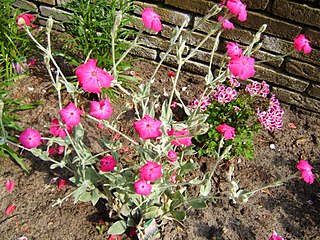
Silene coronaria, the rose campion, is a species of flowering plant in the family Caryophyllaceae, native to Asia and Europe. Other common names include dusty miller, mullein-pink and bloody William. In the United Kingdom it is still widely referenced under its synonym Lychnis coronaria.

Sidalcea is a genus of the botanical family Malvaceae. It contains several species of flowering plants known generally as checkerblooms or checkermallows, or prairie mallows in the United Kingdom. They can be annuals or perennials, some rhizomatous. They are native to West and Central North America.
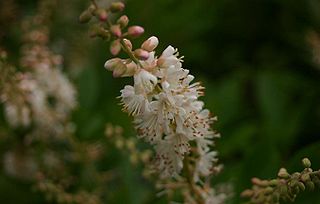
Clethra alnifolia, the coastal sweetpepperbush or summersweet, is a species of flowering plant in the genus Clethra of the family Clethraceae, native to eastern North America from southern Nova Scotia and Maine south to northern Florida, and west to eastern Texas.
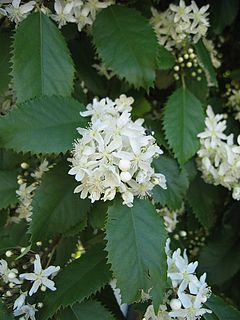
Hoheria is a genus of six species of flowering plants in the family Malvaceae. All are endemic to New Zealand. The genus name is a latinization of the Māori language name, houhere. That name, as well as lacebark and ribbonwood, are often used as common names. The name lacebark comes from the lace-like fibrous inner bark layer.

Malva thuringiaca, the garden tree-mallow, is a species of flowering plant in the mallow family Malvaceae, native to eastern Europe and southwestern Asia, from southern Germany south to Italy, and east to southern Russia, Kazakhstan, and Turkey.

Viburnum plicatum is a species of flowering plant in the family Adoxaceae, native to mainland China, Korea, Japan, and Taiwan. The Latin specific epithet plicatum means “pleated”, referring to the texture of the leaves.

Hylotelephium spectabile is a species of flowering plant in the stonecrop family Crassulaceae, native to China and Korea. Its common names include showy stonecrop, ice plant, and butterfly stonecrop. Growing to 45 cm (18 in) tall and broad, it is an herbaceous perennial with alternate, simple, toothed leaves on erect, unbranched succulent stems. The star-shaped pink flowers are borne in flat cymes 15 cm (6 in) across, in fall (autumn).

Erysimum cheiri, syn. Cheiranthus cheiri, the wallflower, is a species of flowering plant in the family Brassicaceae (Cruciferae), native to Greece, but widespread as an introduced species elsewhere. It is also treated as a hybrid under the name Erysimum × cheiri. It is widely cultivated as a garden plant.

Crocus chrysanthus, the snow crocus or golden crocus, is a species of flowering plant of the Crocus genus in the family Iridaceae. Native to the Balkans and Turkey, it bears vivid orange-yellow bowl-shaped flowers. It has smaller corms and a smaller flower than the giant Dutch crocus, although it produces more flowers per bulb than the latter. Its common name, "snow crocus", derives from its exceptionally early flowering period, blooming about two weeks before the giant crocus, and often emerging through the snow in late winter or early spring. The leaves are narrow with a silver central stripe. Height: 3–4 inches (7.6–10.2 cm).

Lewisia cotyledon is a species of flowering plant in the family Montiaceae known by the common names Siskiyou lewisia and cliff maids. It is native to southern Oregon and northern California, where it grows in rocky subalpine mountain habitat.

Papaver commutatum, the Caucasian scarlet poppy, is a species of flowering plant in the family Papaveraceae native to northern Turkey, northwestern Iran and the Caucasus. It is an erect annual growing to 45 cm (18 in) tall by 15 cm (6 in) wide, with hairy stalks and leaves. The flower is bowl-shaped and about 8 cm (3 in) in diameter, bright red with prominent black blotches at the bases of the petals, and is borne in early summer. The flowers are followed by spherical seed heads.
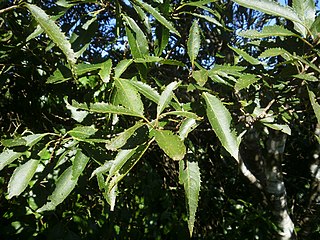
Hoheria sexstylosa, the long-leaved lacebark or ribbonwood, is a species of flowering plant in the family Malvaceae, endemic to New Zealand. It is an evergreen tree or shrub growing to 8 m (26 ft) tall by 6 m (20 ft) broad with glossy green leaves, and white flowers in summer and autumn. This tree tends to have a weeping graceful habit and is sometimes sold by nurseries with the name graceful lacebark. The Latin term sexstylosa means "six styles".

Primula marginata, the silver-edged primrose, is a species of flowering plant in the family Primulaceae, native to the European Alps. It is an evergreen or semi-evergreen perennial growing to 15 cm (5.9 in) tall by 30 cm (12 in) broad, with rosettes of leathery serrated leaves, and stalks bearing umbels of slightly scented lavender flowers in spring. Parts of the plant, including the edges of the leaves, may be covered by a mealy-white bloom, hence the Latin and common names.

Scindapsus pictus, the satin pothos, silver pothos, or silver vine, is a species of flowering plant in the arum family Araceae, native to India, Bangladesh, Thailand, Peninsular Malaysia, Borneo, Java, Sumatra, Sulawesi, and the Philippines.
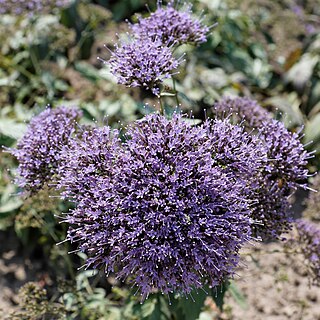
Trachelium caeruleum, common name blue throatwort, is a species of flowering plant in the family Campanulaceae native to the Mediterranean, where its native range includes Algeria, Morocco, Portugal, Spain, and Sicily. It has also become naturalized in a few areas, including New Zealand, the Azores, and parts of mainland Europe.
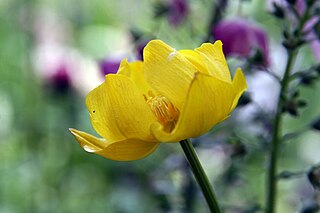
Trollius × cultorum is a group of hybrid flowering plants of garden origin, belonging to the buttercup family Ranunculaceae. There are several cultivars, derived from T. europaeus, T. asiaticus and T. chinensis. These are clump-forming herbaceous perennials whose preferred location is heavy, moist or even boggy ground, in full sun or partial shade. Typically growing to 60 cm (24 in) tall, they bear showy double flowers up to 6 cm (2.4 in) in diameter. Flowers appear in shades of cream, yellow and orange. The curved “petals” are actually sepals, surrounding the smaller, nectar-bearing petals. The spherical or cupped shape of the blooms gives rise to the common name globeflower, which they share with other Trollius species.




















